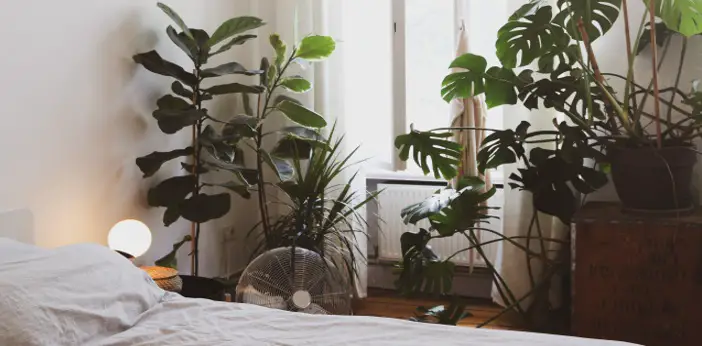Houseplants have grown in popularity in recent years, and for good cause. They not only add greenery and beauty to our homes, but they also have a number of health advantages.
Because the bedroom is a place for relaxation and rejuvenation, having houseplants can be particularly beneficial.
According to research, houseplants can help purify the air by removing toxins and pollutants, resulting in a better night’s slumber.
Furthermore, plants generate nighttime oxygen, which can help to freshen the air and create a more peaceful environment.
Plants in your bedroom can also lower stress and improve your mood, making it a more peaceful place to unwind.
There are a variety of houseplants that can flourish in this environment, regardless of whether your bedroom has plenty of natural light or depends on artificial lighting.
There are numerous plants to choose from, ranging from low-maintenance to show-stoppers, that can add a bit of beauty and tranquility to your bedroom.
Here are the best choices by our panel of experts that we consulted:
Table of Contents
1. Peace Lily

Peace lilies grow in high and low light, making them ideal for bedrooms. When they need water, their plants droop, signaling that they need it. Watering it revives the plants in a few hours.
Peace lilies clean air in bedrooms. These plants remove formaldehyde, benzene, and carbon monoxide, which can pollute indoor air and hurt your health.
Peace lilies add dampness to the air, which is especially useful in winter when indoor heating can dry it out. Increased dampness can relieve dry skin, chapped lips, and respiratory issues.
2. Pothos
Pothos, a common houseplant, has heart-shaped leaves and trailing vines. This low-light-loving shrub is ideal for a bedroom.
Pothos plants dry out between waterings, making them ideal for forgetful plant owners. They endure a range of temperatures, making them ideal for a bedroom where temperatures fluctuate.
Pothos plants enhance air quality in bedrooms. Pothos plants remove formaldehyde, benzene, and carbon monoxide from the air, making them ideal for allergy sufferers.
Pothos plants are beautiful and air-purifying. Their long vines can be draped over a bookcase, dresser, or hung from the ceiling in a hanging planter to add greenery and beauty to your bedroom.
3. Parlor Palm
Parlor palms (Chamaedorea elegans) are common houseplants due to their tropical appearance and low-light tolerance. It’s ideal for a dark bedroom.
Parlor palms need well-drained dirt and water when the top inch feels dry. Misting occasionally raises dampness around the plant.
Parlor palms clean the air in bedrooms. Parlor palms, like other trees, remove formaldehyde, benzene, and carbon monoxide. This improves room air quality, making sleeping easier.
The parlor palm adds tropical charm and purifies the air. After a long day, its lush, green growth creates a relaxing atmosphere in your bedroom.
4. English Ivy

English ivy likes bright, indirect light but can tolerate lower light. Avoid overwatering because it loves to dry out between waterings. English ivy propagates easily from roots.
English ivy purifies chamber air. English ivy, like other vegetation, removes formaldehyde and benzene. This improves room air quality, making sleeping easier.
English ivy is attractive and air-purifying. Its trailing vines can climb trellises or hoops to create a living art piece in your chamber.
English ivy is toxic to pets, so if you have pets, it may not be the best option for your bedroom.
5. Monstera
Monstera, the “Swiss cheese plant,” is a famous houseplant with glossy, split-and-holed leaves. It needs moderate sun and weekly watering.
Monstera plants prefer bright, indirect light but can endure lower light. Keep them dry between waterings. If you have pets, Monstera is toxic, so it may not be the best option.
Monstera purifies air in your chamber. Monstera, like other vegetation, removes formaldehyde and benzene. This improves room air quality, making sleeping easier.
Monstera can beautify your chamber and purify the air. Its lush, glossy leaves can turn your area into a tropical oasis.
6. Snake Plant
Snake plants (Sansevieria trifasciata), also known as mother-in-tongue, law’s are famous houseplants with sculptural, upright growth and leathery, strappy leaves. Its air-purifying and low-maintenance qualities make it a great bedside plant.
Snake plants prefer bright, indirect light but can endure lower light. Let the dirt dry out between waterings since they don’t need much.
They can also live in less-than-ideal conditions, making them ideal for busy people with little time to care for their plants.
Snake plants clean air in bedrooms. It removes airborne benzene, formaldehyde, trichloroethylene, and xylene. This improves room air quality, making sleeping easier.
The snake plant’s sculptural appearance and air-purifying abilities can add appeal to your bedroom decor. Its upright growth and striking foliage add visual appeal to any area.
7. Corn Plant
Corn plant (Dracaena fragrans) is a common houseplant with long, glossy leaves and a tree-like appearance. Due to its low maintenance and adaptability, it makes a great bedside plant.
Corn plants prefer bright, indirect light but can endure lower light. They like well-draining soil and should be watered when the top inch feels dry. Overwatering them can cause root rot.
Corn plants clean air in bedrooms. It removes formaldehyde, benzene, and trichloroethylene from the air. This improves room air quality, making sleeping easier.
The corn plant purifies air and adds natural beauty to any area. Its tree-like look and long, glossy leaves make it a good bedroom plant.
However, if you have dogs, the corn plant is toxic to them.
8. Gerber Daisy
Gerber daisies (Gerbera) can brighten any area. Since they improve indoor air quality and grow cheerfully, they make great bedroom plants.
Gerber flowers need bright, indirect light and water when the top inch of soil feels dry. Allow the dirt to dry between waterings to avoid root rot.
Gerber daisies clear trace organic pollutants from your bedroom air. They can improve indoor air quality, but not as well as other plants.
Gerber daisies also brighten your boudoir. Their vibrant blooms brighten any area and make it inviting.
Gerber daisies are short-lived and must be renewed. They take more care than other plants, so busy people may not want them.
9. Fiddle Leaf Fig
Fiddle leaf figs (Ficus lyrata) are trendy plants with big, fiddle-shaped leaves. They add elegance and natural beauty to any area, making them ideal bedroom plants.
Fiddle leaf figs favor bright, indirect light but can tolerate lower light. They should be watered when the top inch of soil feels dry and placed on a tray of watered pebbles to boost humidity.
A fiddle leaf fig in your chamber can filter out formaldehyde and benzene. This improves indoor air quality and makes breathing easy while sleeping.
The fiddle leaf fig adds elegance and natural beauty to any area in addition to purifying the air. Its large, fiddle-shaped leaves create a tropical, calm atmosphere.
The fiddle leaf fig is finicky and may need more care than other trees. They are delicate to temperature, light, and overwatering, which causes root rot.
10. Philodendron
Philodendrons are common houseplants with trailing foliage. Due to their low care and adaptability, they make good bedroom plants.
Philodendrons enjoy bright, indirect light but can tolerate lower light. To promote healthy growth, water when the top inch of dirt feels dry and fertilize occasionally.
A bedside philodendron removes formaldehyde and benzene from the air. This improves indoor air quality and makes breathing easy while sleeping.
The philodendron purifies air and adds natural beauty to any area. Its lush, trailing foliage can scale trellises or fall over shelves or furniture, creating a peaceful bedroom.
Philodendrons can easily reproduce from cuttings, so you can grow your collection without buying new plants.
11. Spider Plant
Spider plants (Chlorophytum comosum) are popular houseplants with long, slender leaves and the ability to create “spiderettes” that hang from the mother plant.
Air-purifying and low-maintenance, they make great bedside plants.
Spider plants prefer bright, indirect light but can endure lower light. To promote healthy growth, water when the top inch of dirt feels dry and fertilize occasionally.
A spider plant in your chamber can filter out formaldehyde and benzene. This improves indoor air quality and makes breathing easy while sleeping.
The spider plant produces plantlets that can be grown into new plants and purifies the air. You can simply create new plants and grow your collection without buying them.
Spider plants are low-maintenance. They endure a variety of light conditions and are easy to water, making them ideal for busy people or houseplant beginners.
12. Aloe Vera
Popular succulent Aloe vera (Aloe barbadensis) has fleshy, spiky leaves and healing qualities. They make great bedroom plants due to their low care and natural beauty.
Aloe vera prefers bright, direct light but can endure lower light. To promote healthy growth, water when the top inch of dirt feels dry and fertilize occasionally.
Aloe vera plants can clear formaldehyde and benzene from your bedroom air. This improves indoor air quality and makes breathing easy while sleeping.
Aloe vera heals and purifies air. The plant’s leaf gel can mend cuts, burns, and other skin irritations. A bedroom aloe vera plant can support healing and calmness naturally.
Aloe vera is low-maintenance. They endure a variety of light conditions and are easy to water, making them ideal for busy people or houseplant beginners.
Conclusion
Bedroom flowers offer more than just aesthetic value. The interior air quality can be improved and sleep quality enhanced by keeping plants like the peace lily, pothos, and parlor palm in the home.
Medicinal and calming, houseplants like the fiddle leaf fig, snake plant, and aloe vera are perfect for producing a restful and relaxing atmosphere in the bedroom.
In addition to the positive effects they have on one’s body, houseplants can also have a positive effect on one’s mental health by helping one to unwind, lessen tension and anxiety, and boost their disposition.
In general, bringing some greenery into your bedroom can be a simple and effective way to enhance your mood and atmosphere.
You can find a low-maintenance plant that will flourish in your bedroom and offer you joy for years to come.











